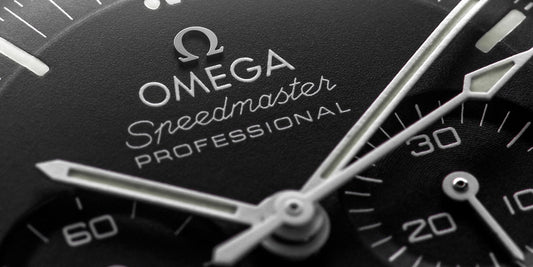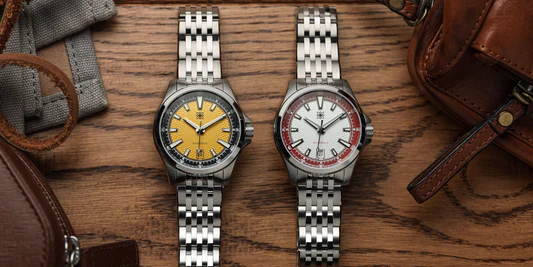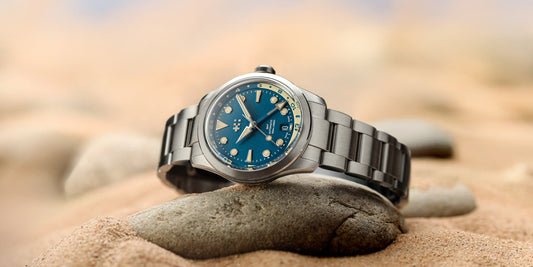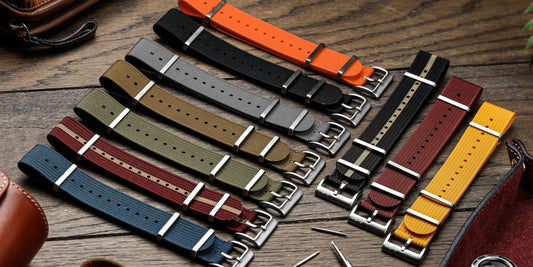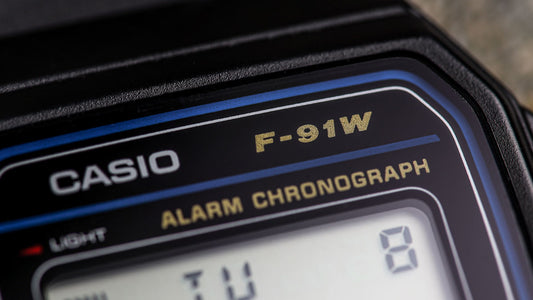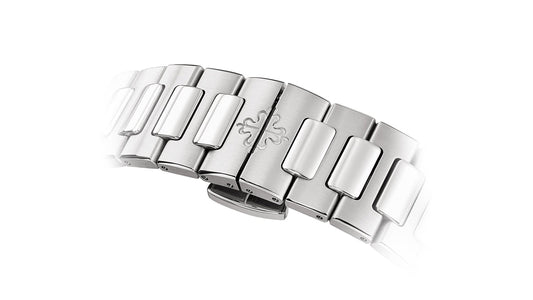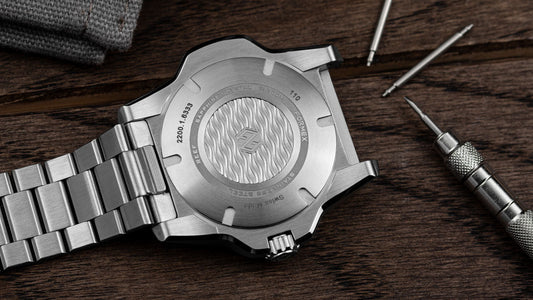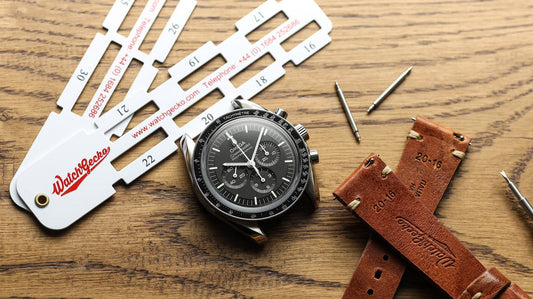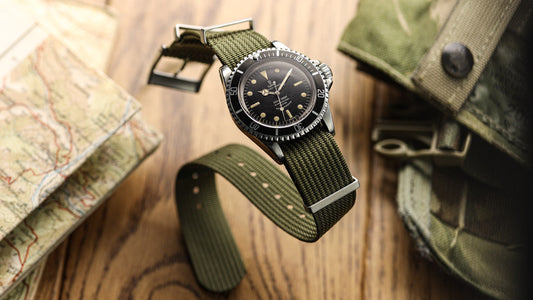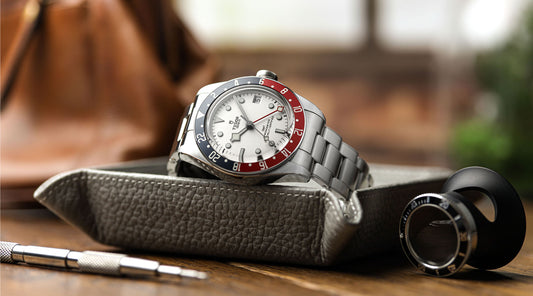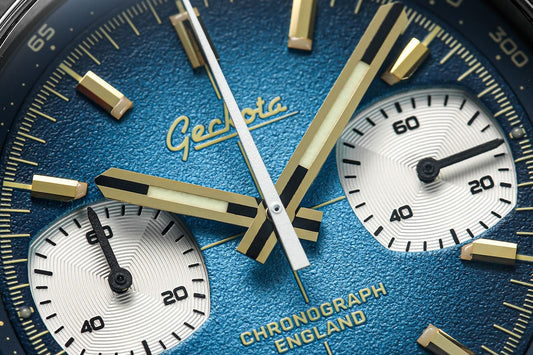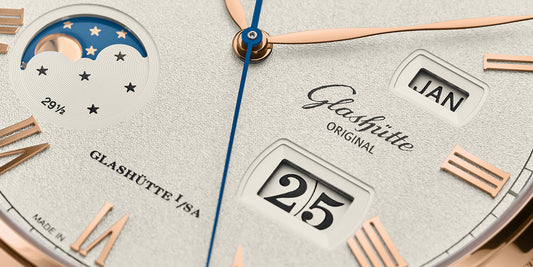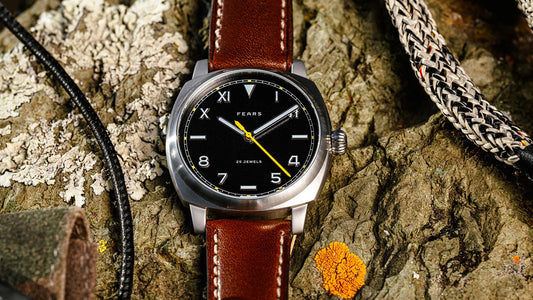The story of racing watches, particularly racing chronographs, goes back over a century. Read about some key watches and people in racing watch history…
Racing watches
From Saint-Imier to the first Geckota Racing Chronograph in eight steps
Think motor racing watches and racing chronographs in particular. A feature in a 2015 WatchTime was subtitled ‘Who wouldn’t want to trade places with a Formula 1 driver? With one of these on your wrist, that dream gets a little more real.’
Ever since man motorised his (or her) wheels competitive instinct led to competition. Measuring that competition, and the difference between victory or defeat, required timepieces. First, conventional pocket watches, then stopwatches and specific motor racing watches. By the early twentieth century, watches jumped from pockets to drivers’ wrists and chronographs did the same. No longer did speeding drivers need to take their hands off the wheel to see elapsed times. The racing chronograph had arrived.
Racing watches are still coveted
From those pioneering days, jump to today. The racing chronograph watch is still coveted, even if worn more as a statement than a practical race timing tool. Among them are some of the most amazing micro-engineering marvels. And some respectful tributes – homages – to watches. And to their wearers from the past.
As with pilots' and navigators' watches in aviation, electronic and computer technology has made mechanical race timekeeping redundant. Still, just as pilot watches still fascinate, and world time and GMT watches adorn pilots and aircrews’ wrists, there’s a nostalgic place for multi-dial auto-racing watches. There’s something cool and evocative about racing watches, with their tachygraph bezels, on a steel bracelet or perforated leather strap.
So here we are on the eve of launching Geckota’s Racing Chronograph. It seems appropriate to drive by a few icons of the racing chronograph’s world – automotive inspired watches, vehicles and people. And as we do so, we’ll celebrate the evolution of this watch type. And some interesting facts. There are some predictable choices, and some that may not be so obvious. Finally, we’ll bring you up to date with our first racing chronograph. And we’ll share some insider secrets about its promotional video.
Strap yourself in as we head onto the track, or take ‘a fast drive in the country’, as someone, with studied understatement, once described the 24 Hours of Le Mans.

The racing chronograph in watch history
The introduction to TAG Heuer 150 Years begins so: ‘This is the story of speed, of the hunt for speed, of catching time, of mastering time.’
It brilliantly summarises the story of racing chronographs and racing inspired watches. It’s a story that goes back to the first time ‘horseless carriages’ went head to head. Today, over a century later, our struggle to master time and move faster through it hasn’t changed. It remains similar to how it was when Edouard Heuer set up his watchmaking workshop in the Swiss Jura region. Only the speeds and the technology have changed.
Later generations of Heuers developed Edouard’s business. With each decade, innovations refined the measurement and management of time. In 1882, Heuer was one of the first to mass produce pocket chronographs. In 1911 they launched the Time of Trip dashboard chronograph. Three years later came the first Heuer bracelet chronographs. Then the first 1/100th of a second Mikrograph/Microsplit and 1/50th second Semikronograph and Semicrosplit stopwatches.
Wristwatches outsell pocket watches
By the 1930s, as Heuer’s dashboard-mounted Autavia chronographs appeared, wristwatches were already outselling pocket watches. Their appeal to drivers was inevitable. Soon, the wrist chronograph’s timing advantages appeared on drivers’ wrists, where it was easier than ever to see their information. Until then, men preferred pocket watches and women’s watches were just bracelets with watches attached. However, as early sportsmen and women started wearing wristwatches – for instance, American racer, Barney Oldfield – their popularity grew.
As the motor car developed into one of the defining twentieth-century technologies, the use of stopwatches and wrist-worn racing watches also grew. The 1950s produced classic watches such as Omega’s Speedmaster and the pre-Daytona Rolex chronographs. Then, in the 1960s and 1970s, just before electronic race timing became ubiquitous, wrist-worn racing chronographs reached their apogee.
Domination of motor sport timing
During the 1970s, such was Heuer’s domination of the racing chronograph market that it would have been easy to believe few top racing drivers wore anything but Heuer.
This was largely due to the efforts of one Jo ‘Seppi’ Siffert. He was one of the world’s fastest and most fearless race drivers until his premature death in 1971. He was also the first sports brand ambassador – for Heuer. More on that later.

A myriad of car-inspired watches
Ever since their invention, cars and watches have consistently been the two ‘toys’ most craved by men. No wonder they’ve developed such a close association. Nowadays, though computerised timing and telemetry means the reign of conventional chronographs for race timing is over. Yet racing chronographs are still hugely popular, as new products or as vintage watches from racing’s heyday.
Nowadays, most major sports car manufacturers have links with watch brands. Then there are automotive-inspired watches from the likes of Alfred Dunhill, Ball and BMW and Baume et Mercier. And don’t forget the plethora of watches inspired by races, rallies and drivers. There’s Alpina and Sebring; Autodromo and Vic Elford; Audemars Piguet and Michael Schumacher; EDOX and the Dakar Rally; and Girard-Perregaux and The Monte Carlo Rally.
The lists go on as the linked names of watchmakers, cars and motor sport events reflect motor sport’s history. Watches for car fans have come a long way since Alfred Dunhill’s early Motorities, the speedometers, odometers and car clocks sold to motorists at the start of the twentieth century.
Unending passion for cars and motor racing
And the reasons for the continued appeal of racing chronographs and other car-inspired watches? It comes back to boys (and girls) and their ‘toys’. It’s about our unending passion for automobiles and watches’ precision engineering. And a passion for bygone golden ages of motor sport and racing watches. It’s also about the practicality of racing watches too. And and the fact that there isn’t much expensive jewellery that men can wear apart from wedding rings or fantastic watches. Ideally, in the case of the latter, one associated with cars!
The characteristics of racing chronographs
So what’s a racing chronograph and what defines car and auto-racing inspired watches? We’ve already covered chronographs in our two-part article on pilot chronographs. Suffice to say that ‘racing chronographs’ are chronographs for use with motor sports. Or to enable drivers, team-members and fans to demonstrate their association with the sport. Many characteristics are similar to those of pilot chronographs:
- Racing watches typically have multiple sub-dials.
- Tachymeter (average speed in a vehicle; ground speed in an aircraft). Early tachymeters were engraved on fixed bezels. Later, greater versatility was introduced with tachymeters on rotating bezels.
- ‘High contrast’ (more ‘information’) watches due to the numerous sub-dials, pushers and tachygraph on the dial and case.
- Dashboard (‘cockpit’) influenced design.
- Large finger-friendly crowns and pushers for easy operation.
- Automotive motifs, such as tyre-tread engraving on Breitling for Bentley or fuel-filler detail on crowns (Chopard).
- Very distinctive automotive-themed straps and bracelets, as depicted in Arno Michael Haslinger’s Heuer Chronographen.
In Timepiece Machines: Stories of Speed, Endurance and Design, John Simonian writes: ‘Today’s most complicated watches have more components than a car, take just as long to build and often command an equal price. In the words of my great friend and watch designer Richard Mille, the best are nothing less than “racing machines on the wrist.”

Suggesting connection with motor racing
All manner of design devices are used to mirror a connection, or suggest association, with performance cars. There are racing stripes, evoking those first applied to Le Mans cars in the 1950s and 1960s to aid identification from the pits. Then there are ORIS racing watches that reference the wheels of F1 cars. On other watches, dials are modelled on instrument clusters and dial surrounds hint at rocker cover gaskets. In the most sophisticated examples, such as Hublot’s MP-05 LaFerrari, the watch case imitates in a stylised way the lines of the car it’s modelled on.
It’s not just watch cases that evoke racing imagery. The rubber strap on Chopard’s Mille Miglia chronograph faithfully reproduces the tread of a 1960s racing tyre. As Haslinger points out in the section on Heuer bracelets and straps, early steel bracelets had ‘the design characteristics of a Dunloptype [sic][sic] later protected the name.’
Investigating further, we discovered an interesting snippet on the Calibre 11 website, included in ‘Ultimate Guide to the Heuer Daytona’. In the article, the authors quote Jack Heuer himself:
‘Daytona was selected because it sounds good and is well known in our key market USA. We basically named many watches according to Racetracks to show indirectly that we where really after the Automotive Sports public!...Rolex did not object, actually we had to register “Heuer Daytona” and Rolex had to register “Rolex Daytona” for its brand protection.’
As Ariel Adams writes in Drive Time, before declaring the Rolex Daytona the ultimate sports chronograph watch: ‘It’s pretty astonishing when a brand becomes a byword for quality, luxury and prestige…the Rolex Daytona effects…the exemplars of a particular luxury category.
Appealing to racers and fans alike
Adams then explains how, in the mid-1960s, Rolex renamed the watch Daytona. Apparently, that was when they became lead sponsor of Florida’s Daytona Raceway and (Adams again), ‘[Rolex]…was looking for further integration into the world of motorsports with a product designed to appeal to both racing fans and those actually behind the wheel.’
Clearly, six decades after the two iconic racing watches were launched, both have secured inviolable positions on the top table of iconic racing watches. ‘Speedy’ or Daytona? Before you decide, remember that racing cars may be fast, but a Saturn V is faster. Maybe once you’ve been to the Moon, nothing else quite compares!
The first ambassador for racing watches?
Mention of Heuer’s Daytona returns us to the world of Heuer and the man who was arguably motor sport’s first brand ambassador, and the first brand ambassador in any sport, the late Jo Siffert.

Jo Siffert has a special association with racing chronographs for several reasons, all originating from his close connection with Heuer and the Autavia wristwatch. Joseph ‘Seppi’ Siffert was an up and coming Swiss racing driver who, as well as driving for Porsche in endurance racing, shot to fame after impressively winning the 1968 British GP. Then an associate suggested to Jack Heuer that he should sponsor Siffert.
As Heuer recalls in his autobiography: ‘We got off to a very good start and quickly agreed on the following: (1) During all races Jo would wear the Heuer logo patch on his overalls and one of our chronographs, preferably the “Autavia”, on his wrist; (2) He would put a red Heuer sticker on the front or the side of all the cars he raced; (3) Heuer would allow him to buy its products at wholesale prices and he would be free to resell them privately to colleagues in the pits and anyone else attending the races; (4) Heuer would pay him an annual fee of CHF 25,000; and (5) the initial contract would be for 2 years.’
Opening the door to Formula 1
For Heuer, sponsoring Siffert opened the door to Formula 1. It wasn’t long before many people in the sport wore Heuers – a trend that continued into the 1970s.
Not only was Siffert fast, but he was an extremely good salesman for the watches he bought at wholesale price from Heuer. Not only did he sell many sports car racing and F1 drivers watches, but, as Fribourg’s Porsche dealer, and someone with an eye for a deal, he also persuaded Jack Heuer to drive Porsches for several years.
As well as sporting a white-dial Autavia Ref. 1123 T in contemporary photographs, Siffert also played a key role in getting Heuer’s Monaco racing chronograph racing chronograph onto Steve McQueen’s wrist in the 1971 movie Le Mans. By all rights, it should have been the Autavia – perhaps the best tachymeter watch ever – that McQueen wore in one of the most accurate-ever film depictions of racing.
Siffert, McQueen and Le Mans
Many people know Siffert was closely involved in the film’s production and did lots of driving. What isn’t so widely known is that he also recruited 10 professional racing drivers and mechanics for filming after the 1970 Le Mans race. He also supplied a Porsche 908, four 911Rs, a Porsche 914/6, two Chevrons and a Chevrolet Corvette for the film. Clearly his salesmanship came to the fore again as his friend and biographer Jacques Deschenaux recalls in Jo Siffert: ‘As for the cost, that had been totted up by Siffert on the basis of [the film being] an important American release…’

Along with Derek Bell, Siffert was assigned to coach McQueen on driving the blisteringly fast Porsche 917. When filming was about to begin, McQueen famously said that he wanted Siffert’s look. So the Swiss racer fetched him a set of his overalls, complete with Heuer logo. When it came to choosing a watch, the only Heuer that the film’s properties department had three of was the Monaco – one for filming, one for stills and one backup. Thus, with McQueen and the Monaco, Heuer racing watches (and the company) were thrust into the cinema’s limelight – on the actor’s chest and wrist. To really imitate Siffert, he’d have worn a Ref. 1123 T. He didn’t, but it didn’t do Heuer – or the square-cased Monaco – any harm on the way to the later success of TAG Heuer Formula 1 chronograph watches! What a shame though, that in 2017, there’s no TAG Heuer Autavia racing chronograph in the range (or so it seemed at the start of writing, before the Heuer Autavia 2017 was relaunched at Baselworld).
Porsche Design’s Titan chronograph
Siffert’s long association with Porsche, on and off the track, leads us neatly to Porsche, or more specifically to Porsche Design. And their unique contribution, with IWC Schaffhausen, to racing chronograph history when they introduced the world’s first titanium chronograph.
Looking back at watch design’s recent history, this is another truly iconic watch that Gisbert L. Brunner describes in The Watch Book II: ‘…large, planar and accordingly ergonomically shaped push-pieces…planned in Germany, designed in Austria and “made in Switzerland,”…’.’
As we read in IWC Schaffhausen: Engineering Time Since 1858: ‘…the watchmaking technical sensation in 1980 was the chronograph, housed for the first time, at the instigation of Porsche, in a titanium case 42 millimetres across…its dial was obviously inspired by the cockpit of a sports car…’
A watch that matched a car
This watch, the Ref. 3704, was one of several from Porsche Design’s 17-year association with IWC – a collaboration that bore some stunning ‘car brand watches’. Earlier, the studio worked with Swiss manufacturer Orfina from 1972 until 1978. The collaboration was driven by F. A. Porsche’s idea that, ‘I wanted to create a watch that matched a car. Black like the speedometer and the rev-counter – because that would be most legible.’ Later, Eterna, by then owned by the Porsche family, took up the association with Porsche Design.
Interestingly, Volkswagen followed in Porsche Design’s direction, with its own design organisation called. With Teutonic predictability, Volkswagen Design. Their first watch project was a collaboration with Fortis on the limited edition (2012 pieces) Fortis Spaceleader ETA Valjoux 7750 chronograph. The watch featured very simple, distinctive ‘banana-shaped’ chronograph pushers and a rubber outer casing that capture the essence of ‘future automotive-related design forms’. The chronograph won three industrial design awards before its 2010 launch. In the same year, a 1939 BMW 328 Mille Miglia Coupe won the Mille Miglia Storica road rally over the traditional Mille Miglia route from Brescia to Brescia via Padua, Rome and Parma. From a horological perspective, the gruelling event had inspired the family-owned Chopard watch business for over a decade…
Chopard Mille Miglia Chronograph
The announcement of a new Chopard Mille Miglia chronograph is fast becoming an annual institution. This is largely thanks to the German Scheufele family’s passion for vintage racing and rallying, and annual model updates for each year’s Mille Miglia Storica – and pictures like the one of supermodel Eva Herzigova in the driver’s seat of a 1950s Porsche 550 Spyder (see pages 54–55 of Drive Time)…

Specialising in car racing watches
Either way, Chopard watchmaking goes back to 1860 when Louis-Ulysse Chopard set up in Sonvilier, near Saint-Imier (the initials L.U.C. live on in Chopard’s sub-brand of the same name).
In 1963, the year Rolex launched its first Cosmograph, the Scheufeles – already connected with jewellery and watches – bought Chopard. Since then, Chopard has continued to be an innovative watch and movement manufacturer. As well as specialising in car racing watches, they’re strongly associated with classic racing, the Mille Miglia Storica, the Chopard Grand Prix de Monaco Historique, automotive stylist Zagato, rally ace Romain Dumas and multi-Le Mans winner Jacky Ickx. They’re also Porsche Motorsport’s official timing partner.
Chopard’s approach to luxury and vintage racing watches contrasts with others, such as TAG Heuer and Rolex. The latter’s collections are based on progression of single models such as the Cosmograph Daytona. Compare that to Chopard’s approach, as described by Aaron Sigmond in Drive Time:
‘Of all the race-inspired watches, whether classic or contemporary, Chopard’s Mille Miglia is singular, the resulting collection conceptual and ever changing … The result of this more than a quarter-century of dedication is a collection of watches that include various interpretations of the core vintage racing and automotive design in the form of chronographs, GMTs, XLs…’
Motorsport blood running through Chopard
The classic motorsport blood running through the company is clear from the details of Chopard’s latest 1000 Miglia timepieces. Power reserves mimic fuel gauges and sub-dials are inspired by instrument clusters. There are also crowns crafted in the form of miniature fuel fillers, chrono pushers like brake pedals and bezels redolent of head gaskets.
And the focal point of the dial? It’s the fire-engine red ‘1000 Miglia’ arrow motif, like the rally’s route signs, surrounding a date window showing racing numbers… All on a strap that replicates the tread pattern of 1960s Dunlop CR48 racing tyres.
As Chopard’s co-president, Karl-Freidrich Scheufele is quoted as saying: ‘Watches and automobiles both represent a seemingly eternal fascination for mechanics, engineering, design, performance and precision.If diamonds are a woman’s best friend, then perhaps for men, it’s mechanical watches and autos.’
The Heuer Camaro that we mentioned earlier predated the first running of the Mille Miglia Storica by a decade. Now, Geckota has chosen this lesser-known Heuer for its first respectful tribute to racing chronographs.

The Geckota Racing Chronograph
By 2016, Geckota had already visited Fliegeruhren, pilots’ chronographs and cushion-case divers for its growing range. Racing style watches were a logical choice for another project. Maybe a classic racing chronograph updated with contemporary twists? Maybe a Heuer Camaro-inspired racing watch?
Geckota’s design lead, Ben Adams, explains: ‘We set out to create a watch that pays respectful homage to the classic, vintage racing chronograph watches of the period, with a stylish appearance that always looks good. Aiming squarely at the market for racing watches under 500 pounds/dollars, we took some of the best features of classic designs and added our own twists. We made sure they were subtle enough not to appear out of place, yet striking enough to enhance the best of the 1970s.’

Breathe in the atmosphere of racing
‘So we included a more prominent bezel alongside the drilled lugs that were characteristic of the period. And we engraved the case back, where the racing chronos of nearly 50 years ago usually had plain backs. The colour combinations are slightly subtler than those that were popular in the 1960s and 1970s. Though evocative of timekeeping at Le Mans, Spa or Monza, they’re not quite as 'in your face' as, say, a 'panda-faced' Daytona. Add a stylish period strap, shut your eyes, smell the fuel and tyres and you could be in the Nurburgring pit lane in 1970...'
To promote the new chronograph online needed a rather special video. For that, Matt Lipski, one of Geckota’s multimedia specialists tracked down a great sequence from 1976 thriller The Swiss Conspiracy. He then edited it with pictures and video of the three new Geckota watches. The film, complete with soundtrack, captures the mid-1970s perfectly, the golden age of racing chronographs, a time when Ferrari’s Daytona V12 was every schoolboy’s dream car and grand touring in the Swiss Alps was still exotic and a little bit glamourous.
Over the Susten Pass in two Ferrari Daytonas
The Swiss Conspiracy (Per Saldo Mord in some markets), is in the public domain and available in full on YouTube, starred David Janssen and Senta Berger. The sequence in question involves a playful ‘race’ between Janssen and Berger in two rare Ferrari GTS/4 ‘Daytonas’. Berger’s is a pure convertible; the other is a ‘Targa’ topped version. As for the watches Janssen and Berger are wearing? We haven’t a clue…
A bit of investigation, the writer’s knowledge of Switzerland and an email to Meiringen tourist office was revealing. Filming was done west to east along Hauptstrasse 11, the mountain highway between Gadmen and the Susten Pass. Having identified the stretch of road where the cars go in and out of short tunnels at Steingletscher, we used a prototype Geckota Racing Chronograph to time the cars’ exits from two consecutive tunnels. We then compared the times with a measured distance on the Swiss topographical map. Our calculations showed that the Ferraris were running nose to tail at around 96 mph – just over half the Daytona’s top speed, but still exciting.
You can watch the film online, or buy the DVD for a couple of pounds. Either way, cut to the chase (the best bit of a lukewarm 1970s production that gets 4.9/10 on IMDB) at 47:30.
Straps for classic racing watches
So you’re inspired to treat yourself to a racing chronograph. Maybe it will be a vintage Rolex Cosmograph Daytona. Or how about an affordable quartz or meca-quartz timepiece? On the other hand, maybe you’ve decided to put your smartwatch away and give your old TAG Heuer Carrera chronograph some long-overdue wrist time. Either way, you’ll need a suitably complementary strap or bracelet to go with it.
Vintage racing straps always work well
Vintage racing straps in pull-up leather, with small perforations and chunky stitching, always work well with racers. So do rallye straps with larger cutaways. You might even find a perforated metal bracelet if you look hard. Those of us old enough to remember reading Motor Sport in the 1970s will remember the ads for these.
While we’re discussing bracelets, it’s worth mentioning that shark-meshes or Milanese mesh look great with racing watches. This is particularly so if you go for a satin or brushed finish without the ‘high-bling’ of polished versions. If possible, look at the section on bracelets and straps at the back of Heuer Chronographen to see the variety of stainless steel bracelet styles that Heuer have used. From this, you’ll realise that almost any oyster, engineer or mesh bracelet can complement a racing watch beautifully – whether it’s a budget racing chrono or a valuable vintage Omega Speedmaster. And of course, that old staple of the watch drawer, the timeless, versatile, military style strap works well too.

Welcome to the world of racing watches
So there you have it, a quick look at a few aspects of the complex, wide-ranging, but always fast-paced world of racing chronographs. If you already own one, you’ll understand what the excitement’s about. And if you haven’t, maybe it’s time to take the plunge and experience the adrenaline rush and association with your favourite moments in racing.
Whether you choose a super-luxury timepiece, one of the iconic vintage racing watches, or seek your adrenaline rush among the more affordable racing watches, the road ahead is yours! Gentlemen, and ladies, strap on your racing watches and start your engines!


